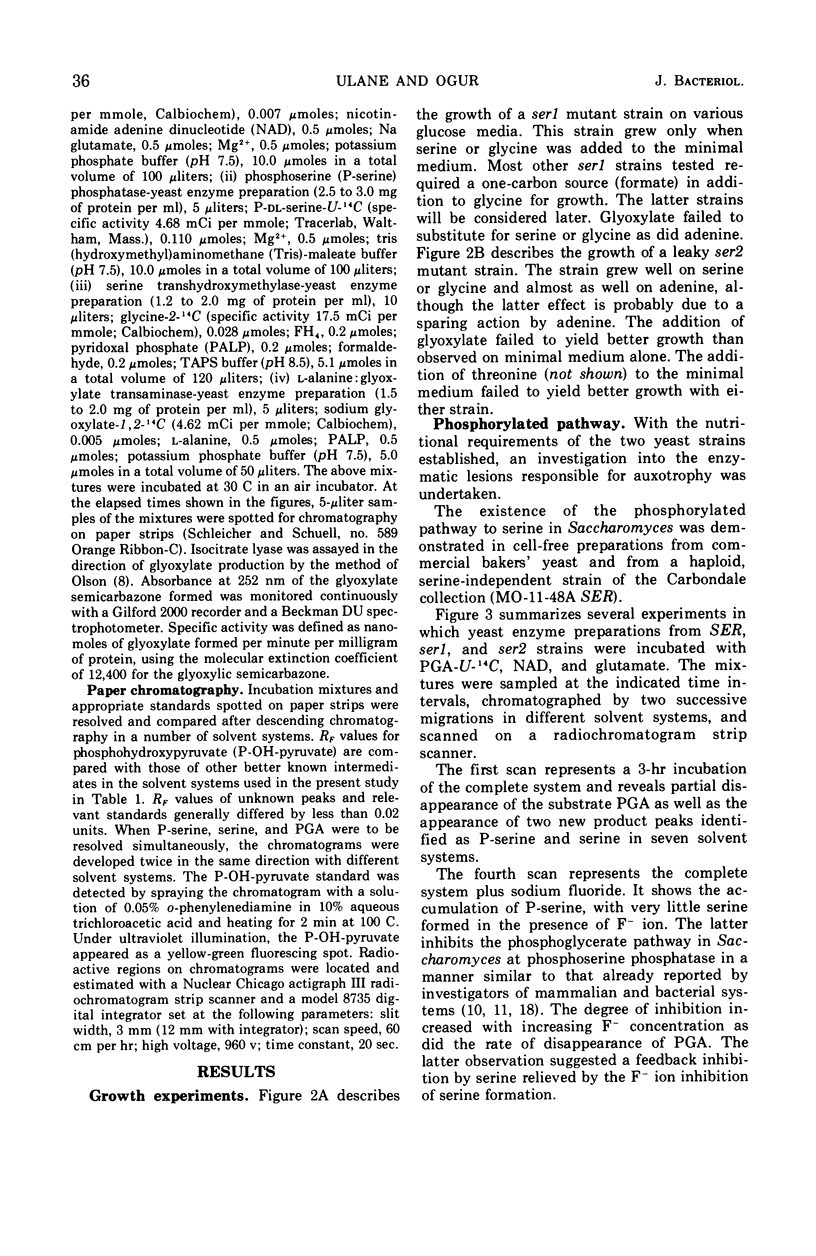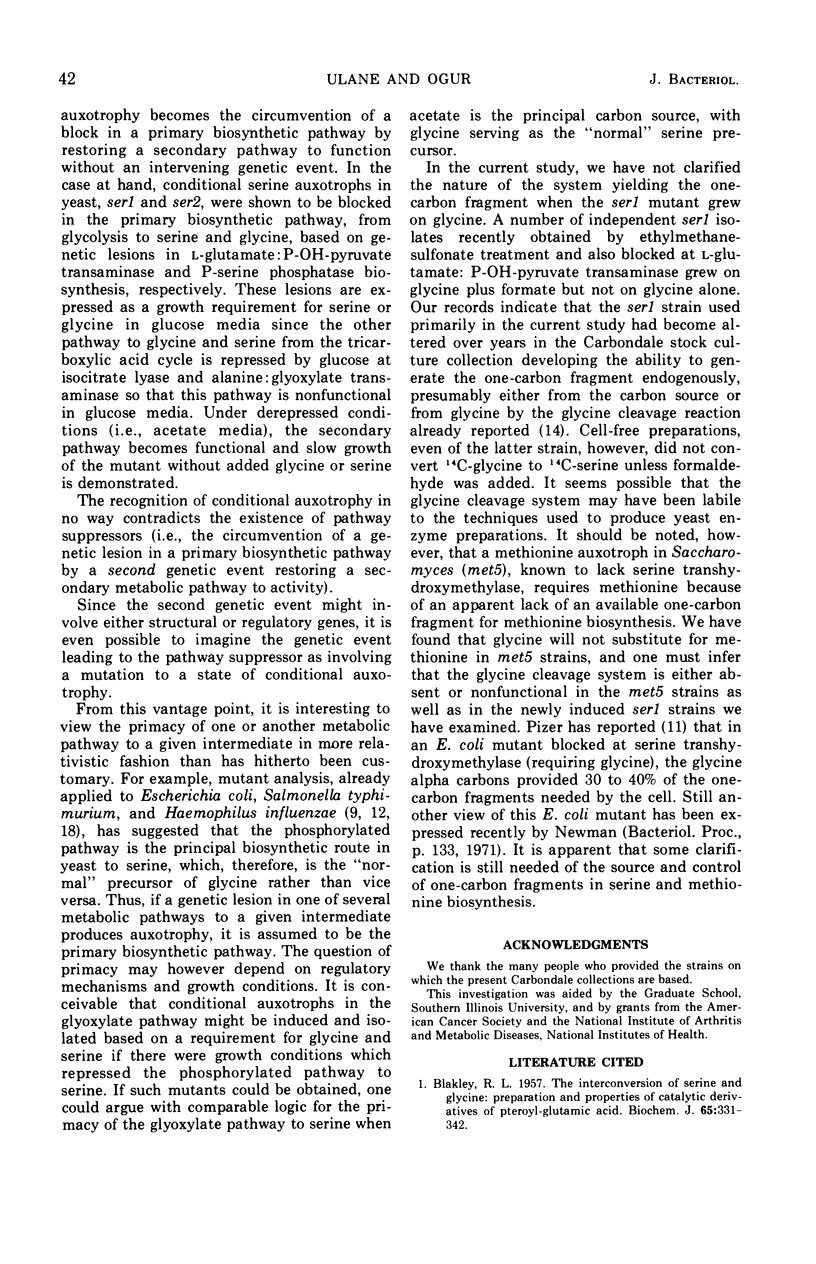Abstract
Two of the three known metabolic pathways to serine and glycine have been shown to be present in prototrophic yeast strains, i.e., the phosphorylated pathway from glycolytic intermediates and the glyoxylate pathway from tricarboxylic acid cycle intermediates. Two serine-glycine auxotrophs (ser1 and ser2) were found to be blocked in the phosphoglycerate pathway. The ser1 gene controls l-glutamate:phosphohydroxypyruvate transaminase biosynthesis, and the ser2 gene controls phosphoserine phosphatase biosynthesis. The other pathway to glycine, from isocitrate, is repressed by growth in glucose media, specifically, at isocitrate lyase and at the alanine:glyoxylate transaminase. This pathway is derepressed by growth to stationary phase in glucose media yielding high activity of these enzymes. The phosphorylated pathway appears to be the principal biosynthetic pathway to serine and glycine during growth on sugar media. Strains which are serine-glycine dependent in glucose media became capable of serine-glycine independent growth on acetate media. These results describe a method of physiological control of a secondary metabolic pathway allowing a single lesion in the principal biosynthetic pathway to produce auxotrophy. This may be termed conditional auxotrophy.
Full text
PDF









Images in this article
Selected References
These references are in PubMed. This may not be the complete list of references from this article.
- BLAKLEY R. L. The interconversion of serine and glycine; preparation and properties of catalytic derivatives of pteroylglutamic acid. Biochem J. 1957 Feb;65(2):331–342. doi: 10.1042/bj0650331. [DOI] [PMC free article] [PubMed] [Google Scholar]
- Botsford J. L., Jr, Parks L. W. Serine transhydroxymethylase in methionine biosynthesis in Saccharomyces cerevisiae. J Bacteriol. 1969 Mar;97(3):1176–1183. doi: 10.1128/jb.97.3.1176-1183.1969. [DOI] [PMC free article] [PubMed] [Google Scholar]
- De Boiso J. F., Stoppani A. O. Metabolism of serine and glycine in baker's yeast. Biochim Biophys Acta. 1967 Oct 9;148(1):48–59. doi: 10.1016/0304-4165(67)90278-4. [DOI] [PubMed] [Google Scholar]
- GILVARG C., BLOCH K. The utilization of acetic acid for amino acid synthesis in yeast. J Biol Chem. 1951 Nov;193(1):339–346. [PubMed] [Google Scholar]
- GREENBERG D. M., ICHIHARA A. Further studies on the pathway of serine formation from carbohydrate. J Biol Chem. 1957 Jan;224(1):331–340. [PubMed] [Google Scholar]
- NAKADA H. I. GLUTAMIC-GLYCINE TRANSAMINASE FROM RAT LIVER. J Biol Chem. 1964 Feb;239:468–471. [PubMed] [Google Scholar]
- OLSON J. A. The purification and properties of yeast isocitric lyase. J Biol Chem. 1959 Jan;234(1):5–10. [PubMed] [Google Scholar]
- PIZER L. I. ENZYMOLOGY AND REGULATION OF SERINE BIOSYNTHESIS IN CULTURED HUMAN CELLS. J Biol Chem. 1964 Dec;239:4219–4226. [PubMed] [Google Scholar]
- PIZER L. I. GLYCINE SYNTHESIS AND METABOLISM IN ESCHERICHIA COLI. J Bacteriol. 1965 Apr;89:1145–1150. doi: 10.1128/jb.89.4.1145-1150.1965. [DOI] [PMC free article] [PubMed] [Google Scholar]
- PIZER L. I. THE PATHWAY AND CONTROL OF SERINE BIOSYNTHESIS IN ESCHERICHIA COLI. J Biol Chem. 1963 Dec;238:3934–3944. [PubMed] [Google Scholar]
- Pizer L. I., Ponce-de-Leon M., Michalka J. Serine biosynthesis and regulation in Haemophilus influenzae. J Bacteriol. 1969 Mar;97(3):1357–1361. doi: 10.1128/jb.97.3.1357-1361.1969. [DOI] [PMC free article] [PubMed] [Google Scholar]
- RABSON R., TOLBERTNE, KEARNEY P. C. Formation of serine and glyceric acid by the glycolate pathway. Arch Biochem Biophys. 1962 Jul;98:154–163. doi: 10.1016/0003-9861(62)90161-3. [DOI] [PubMed] [Google Scholar]
- SAGERS R. D., GUNSALUS I. C. Intermediatry metabolism of Diplococcus glycinophilus. I. Glycine cleavage and one-carbon interconversions. J Bacteriol. 1961 Apr;81:541–549. doi: 10.1128/jb.81.4.541-549.1961. [DOI] [PMC free article] [PubMed] [Google Scholar]
- SCHRAMM M. O-phosphoserine phosphatase from Baker's yeast. J Biol Chem. 1958 Nov;233(5):1169–1171. [PubMed] [Google Scholar]
- Sojka G. A., Garner H. R. The serine biosynthetic pathway in Neurospora crassa. Biochim Biophys Acta. 1967 Oct 9;148(1):42–47. doi: 10.1016/0304-4165(67)90277-2. [DOI] [PubMed] [Google Scholar]
- UMBARGER H. E., UMBARGER M. A., SIU P. M. BIOSYNTHESIS OF SERINE IN ESCHERICHIA COLI AND SALMONELLA TYPHIMURIUM. J Bacteriol. 1963 Jun;85:1431–1439. doi: 10.1128/jb.85.6.1431-1439.1963. [DOI] [PMC free article] [PubMed] [Google Scholar]
- WADDELL W. J. A simple ultraviolet spectrophotometric method for the determination of protein. J Lab Clin Med. 1956 Aug;48(2):311–314. [PubMed] [Google Scholar]
- WILLIS J. E., SALLACH H. J. Evidence for a mammalian D-glyceric dehydrogenase. J Biol Chem. 1962 Mar;237:910–915. [PubMed] [Google Scholar]
- Wang D., Waygood E. R. Carbon metabolism of C-labeled amino acids in wheat leaves. I. A pathway of glyoxylate-serine metabolism. Plant Physiol. 1962 Nov;37(6):826–832. doi: 10.1104/pp.37.6.826. [DOI] [PMC free article] [PubMed] [Google Scholar]
- Witt I., Kronau R., Holzer H. Repression von Alkoholdehydrogenase, Malatdehydrogenase, Isocitratlyase und Malatsynthase in Hefe durch Glucose. Biochim Biophys Acta. 1966 Jun 15;118(3):522–537. [PubMed] [Google Scholar]



